Last Updated on April 5, 2024
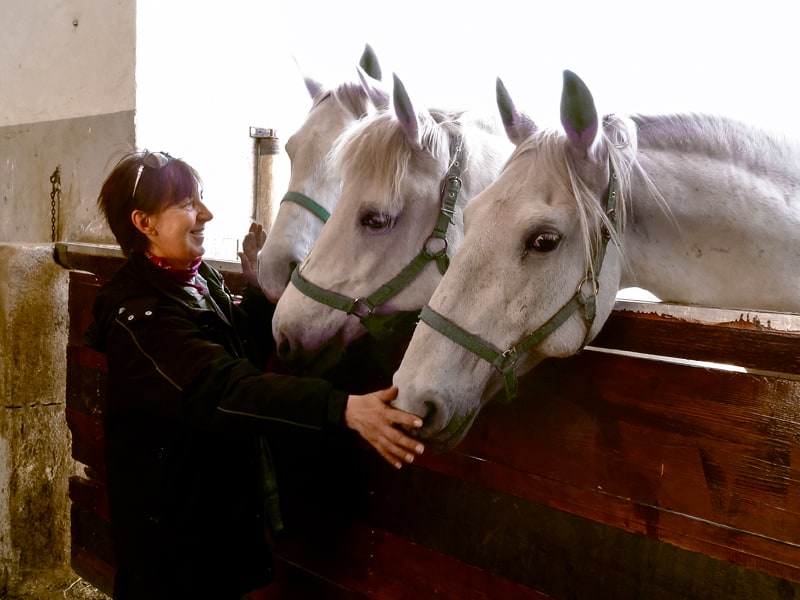
The Lipica Stud Farm in Slovenia, where the beautiful Lipizzaners popularized in Austria’s Spanish Riding School originated, is close to the Italian border and the Slovenian capital Ljubljana. It’s an easy and fantastic day trip from either northeastern Italy or Ljubljana, Slovenia.
Estimated reading time: 8 minutes
Updated for 2023
By Jim Ferri
If you travel a lot, every so often you’ll usually find something unusual and heartwarming. Oftentimes, it becomes an incredible experience and memory.
I know from experience. I had a phobia about horses since childhood, which I lost at the Lipica Stud Farm in Slovenia. The Farm is where the great Lipizzaner horses are developed and bred. There are now approximately 300 white horses on the farm.
In fact, the breed is named for this Farm that’s just a few minutes from the Italian border at Trieste. In fact, Lipica is spelled Lipizza in Italian, why the breed has become known as Lippizan and Lipizzaner.
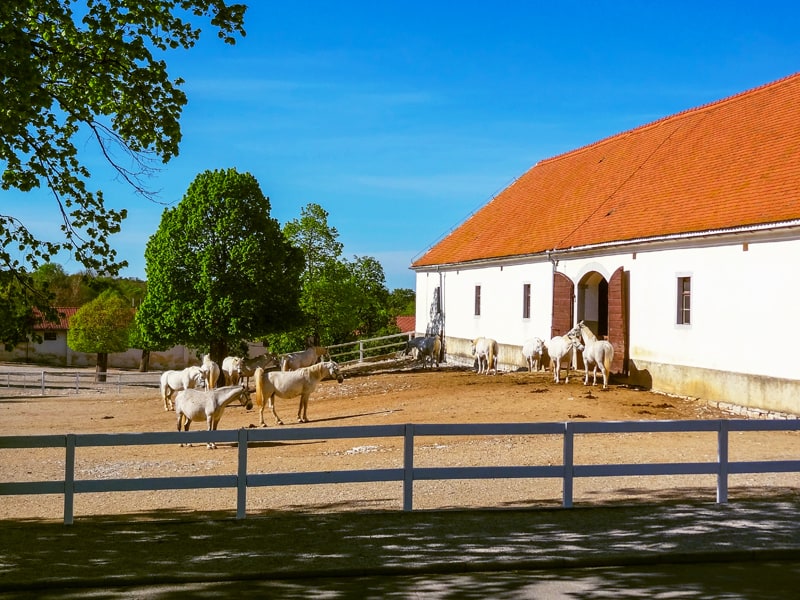
First, A Little History
In the 16th century, the rulers of the Habsburg empire considered the Spanish horse an ideal breed. Since horses were of military importance at the time, this was of significance to the Habsburgs, which controlled a large part of Europe.
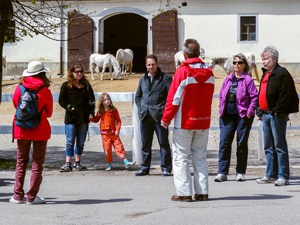
In 1581, 24 broodmares and six stallions were bought in Spain, after Archduke Charles built the royal Lipica stud farm. The location was chosen because the plateau region of southwestern Slovenia and northeastern Italy, in which Lipica is located, was very similar to Spain’s.
The breed, such as it is known today, is the result of it being developed in the times under Empress Maria Theresa (1740-1780). But during ensuing wars right up to post-World War II, the herd was moved numerous times. Many of the horses were appropriated by the ruling powers.
In fact, the 1963 Disney film “The Miracle of the White Stallions” is about the repatriation of the Lipizzaners from the Germans.
Following the withdrawal of Allied Forces in 1947, Lipica became part of Yugoslavia. Unfortunately, it received only 11 horses from the herd confiscated by the Germans. After the breed recovered in the 1960s, the stud farm opened to tourism.
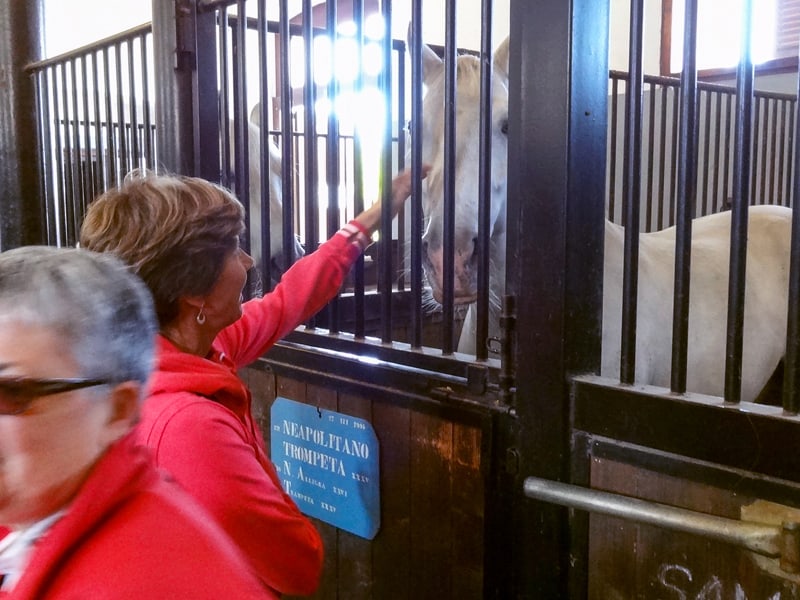
Today’s Farm
I don’t recall how I learned of the Farm, but I got in touch with them when I was in Slovenia and asked if I might stop by. They invited me over and my morning there turned out to be most memorable.
The Lipica Stud Farm is just an hour’s drive from Ljubljana and a stone’s throw (perhaps a 20-minute drive) from the Italian border near Trieste. When we entered the Farm, we drove through beautiful pastureland lined with white fences. It is so picture-perfect you’d think you’re in a movie.
I arrived at the Maestoso Hotel, which is also the administrative offices of the Farm. I was taken in tow by Uljana Ozbič, the public relations director, who walked with me over to the nearby stable area.
The barns at the Lipica Stud Farm aren’t wooden, but old-fashioned stucco buildings. They’re much like, I expect, the originals in the 16th century. As we approached, I saw 12 to 15 Lipizzaners in a paddock outside a large barn, standing almost motionless except for an occasional swish of a tail. Uljana explained they were mares waiting to give birth in the next few weeks.
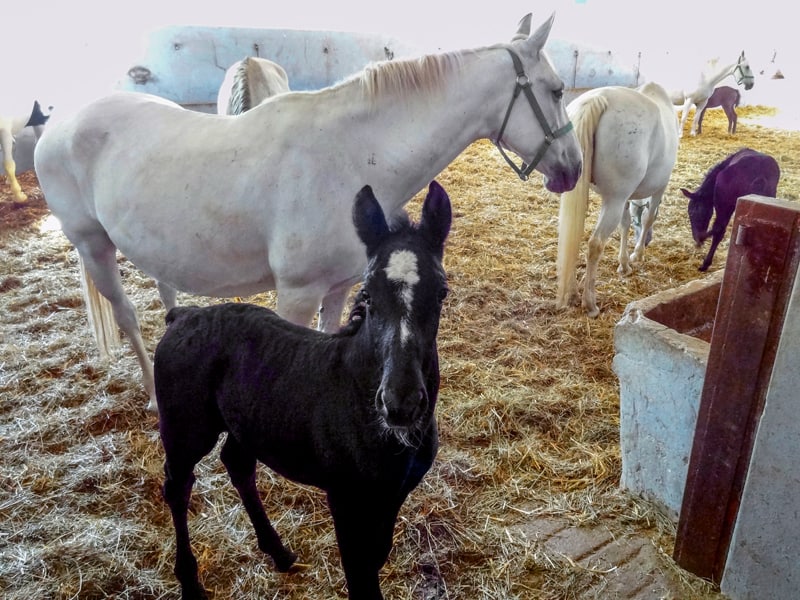
The Mares and Their Foals in the Lipica Stud Farm
When we entered the barn, we found a mare with her week-old foal in the first stall. I had never been near a foal before, and being just about five feet away was incredible. We continued walking along the stalls and soon came upon six more mares. Some were with foals only a few days old.
After a few weeks, if the foal and the mare are in good health, they move to a larger area in the same barn. There they’re free to roam around with other mares and foals. We walked over and found several mares and 4- to 6-week old foals there.
Despite my Equinophobia, I quickly realized these Lipizzaners were all exceptionally gentle, a characteristic of the breed. Whenever I walked up to a stall, they would all come over and put the heads over the gate.
I soon was rubbing the foreheads and cheeks of these gentle giants, amazed by how comfortable I was around them.
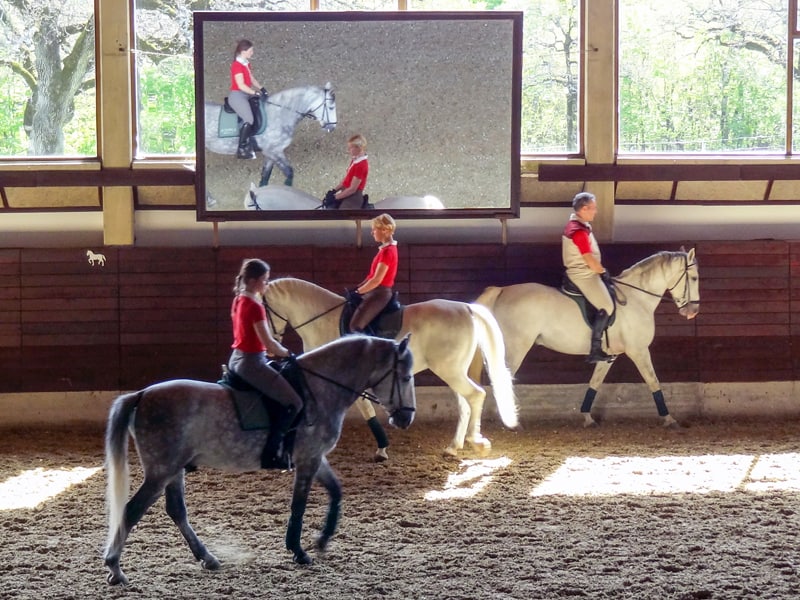
Treated Like Pets
In addition to their gentleness, I soon also realized how incredibly quiet they all were, as well. I never heard any of them neighing or whinnying or making the usual horse sounds. And this from horse almost everywhere about me.
When I stood chatting, at times, someone would walk by with a horse. They always looked as casual as if they were walking their dog in front of my home. It was then I realized that the Lipizzaners at the Lipica Stud Farm are treated more like pets than as farm animals.
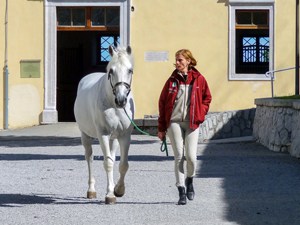
When initially bred centuries ago, all Lipizzaners were different colors. Local mythology, however, says the Habsburg emperors may have wanted a white horse because the color signified being divine or godlike. They’re born brown and then turn lighter, usually between four and eight years of age.
As we walked between barns, which had none of the usual barn aromas either, Uljana showed me a little chapel. It was once the church of the farmworkers who lived in the village. Near it was a small museum. It was built with a grant from Iceland, Liechtenstein, and Norway, as part of the European cultural funding program.
The museum is small and perfectly sized, and when you enter, the first thing you see is a 20-second video. I watch with pleasure the video of mares and their foals galloping out into a spring pasture like kids heading for a picnic. It’s a great place to learn more about the breed.
After a while, we walked over to another barn and found stallions in different stalls, since the stallions must kept separate from one another. If allowed to roam together, they’d likely hurt one another to be dominant.
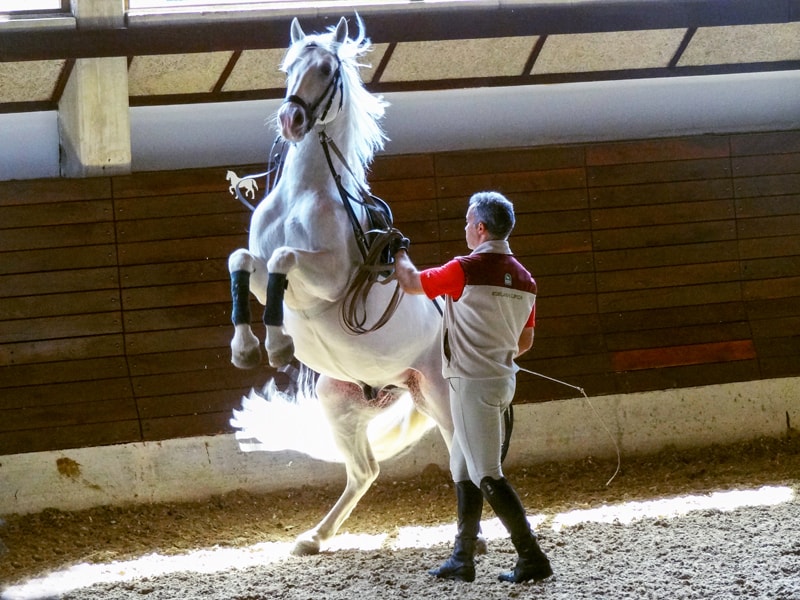
The Classical Riding School at the Lipica Stud Farm
Our final stop was at the large riding hall where horses are trained for the classical riding school. (Performances take place April to the end of October). I learned it takes 8 to 12 years to train a horse.
At the time, there were about 80 stallions in training), and it was fascinating watching them go through their practice sessions, so regally and beautifully. On the walls were large mirrors to allow riders to view their horse’s performance.
You may also enjoy: Things to Do in Ljubljana / Day-Tours in 5 of the Best Eastern European Cities / River Cruising Through Eastern Europe
When it came time to leave. I was reluctant to do so since I was so fascinated by the horses and the Farm. But I was on a schedule and had to catch a train in Trieste.
I left knowing, however, that I had discovered something so few people get to see. I also realized I had found a place that changed my view of these beautiful animals and made a unique history connection.
If you’re ever traveling in Slovenia or southern Austria or northeast Italy, I’d suggest that you take a detour to Lipica. You can touch a bit of history and enjoy your own morning of discovery.
If You Go:
Lipica Stud Farm / Kobilarna Lipica
Lipica 5
6210 Sežana
Slovenia
[email protected]
Tel: (0)5 739 1696
Admission: the cost of a visit to the stud farm is from € 9-49 (the latter for a family). A combination ticket for a visit to the farm plus a show by the Lipica Riding School is €25pp. There are also carriage rides and other events at an additional cost. Private tours are also available from Ljubljana and Trieste, since both cities are so close to the Farm.

Jim, I’m so happy you learned to trust these beautiful animals. 3 years ago I added the Spanish Riding School to my bucket list. Don’t miss this stupendous performance the next time you are in Vienna.
Hi Carole,
Thanks for the note and words of encouragement. I think what helped me overcome it the phobia, was that these beautiful animals trusted me. Have always wanted to go to the Spanish Riding School but often wound up in Vienna at the wrong time or was in the city for a short period en route elsewhere.
Jim
A fascinating book is The Perfect Horse by Elizabeth Letts, the true story of the daring US mission to rescue the priceless Lipizzaner stallions kidnapped by the Nazis during WW11
Hi Mary,
You’re absolutely right. I’ve mentioned Elizabeth’s short article “Movie vs. Book” for those who don’t want to read the entire book. But certainly, the book provides a lot more information. It appears that Patton disobeyed orders and undertook a clandestine operation in Russian-held territory. Fascinating.
Jim